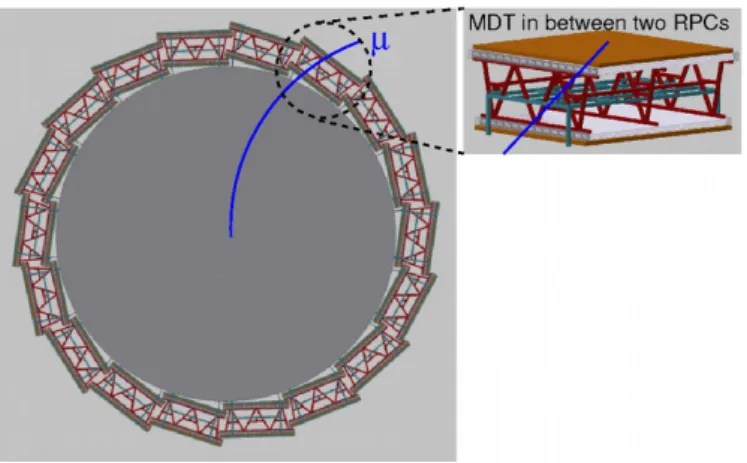Elsevier Editorial System(tm) for NIMA Proceedings
Manuscript Draft
Manuscript Number: NIMA_PROCEEDINGS-D-18-00325
Title: First-Level Muon Track Trigger for Future Hadron Collider Experiments
Article Type: SI: PisaMeeting2018
Keywords: Front End, Trigger, DAQ and Data Management Corresponding Author: Dr. Oliver Kortner, PD Dr.
Corresponding Author's Institution: Max-Planck-Institut füf Physik First Author: Oliver Kortner, PD Dr.
Order of Authors: Oliver Kortner, PD Dr.; Sergey Abovyan; Davide Cieri;
Varuzhan Danielyan; Markus Fras; Philipp Gadow; Sandra Kortner; Hubert Kroha; Felix Müller; Sebastian Nowak; Robert Richter; Korbinian Schmidt- Sommerfeld
Abstract: Single muon triggers are crucial for the physics programmes as hadron collider experiments. To be sensitive to electroweak processes, single muon triggers with transverse momentum thresholds down to 20 GeV and dimuon triggers with even lower thresholds are required. In order to keep the rates of these triggers at an acceptable level these triggers have to be be highly selective, i.e. they must have small accidental trigger rates and sharp trigger turn-on curves. The muon systems of the LHC experiments and experiments at future colliders like FCC-hh will use two muon chamber systems for the muon trigger, fast trigger chambers like RPCs with coarse spatial resolution and much slower precision chambers like drift-tube chambers with high spatial resolution. The data of the trigger chambers are used to identify the bunch crossing in which the muon was created and for a rough momentum measurement while the precise measurements of the muon trajectory by the precision chambers are ideal for an accurate muon momentum measurement. A concept for the muon trigger of the baseline detector for the FCC-hh which exploits the precision measurements of drift-tube chambers is presented including the
description and the test of a compact muon track reconstruction
algorithm.
Title of the manuscript
First-Level Muon Track Trigger for Future Hadron Collider Experiments List of authors
S. Abovyan, Max-Planck-Institut für Physik, Föhringer Ring 6, 80805 München D. Cieri, Max-Planck-Institut für Physik, Föhringer Ring 6, 80805 München V. Danielyan, Max-Planck-Institut für Physik, Föhringer Ring 6, 80805 Münche M. Fras, Max-Planck-Institut für Physik, Föhringer Ring 6, 80805 München Ph. Gadow, Max-Planck-Institut für Physik, Föhringer Ring 6, 80805 München O. Kortner, Max-Planck-Institut für Physik, Föhringer Ring 6, 80805 München S. Kortner, Max-Planck-Institut für Physik, Föhringer Ring 6, 80805 München H. Kroha, Max-Planck-Institut für Physik, Föhringer Ring 6, 80805 München F. Müller, Max-Planck-Institut für Physik, Föhringer Ring 6, 80805 München S. Nowak, Max-Planck-Institut für Physik, Föhringer Ring 6, 80805 München R. Richter, Max-Planck-Institut für Physik, Föhringer Ring 6, 80805 München
K. Schmidt-Sommerfeld, Max-Planck-Institut für Physik, Föhringer Ring 6, 80805 München
Problem statement
Proposal for a highly selective muon trigger for future hadron collider experiments.
Cover Letter
NIMA POST-PROCESS BANNER TO BE REMOVED AFTER FINAL ACCEPTANCE
First-Level Muon Track Trigger for Future Hadron Collider Experiments
S. Abovyan, D. Cieri, V. Danielyan, M. Fras, Ph. Gadow, O. Kortner, S. Kortner, H. Kroha, F. Mller, S. Nowak, R. Richter, K. Schmidt-Sommerfeld
aa
